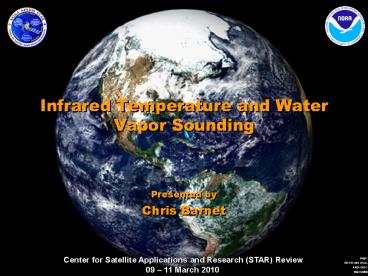Infrared Temperature and Water Vapor Sounding - PowerPoint PPT Presentation
Title:
Infrared Temperature and Water Vapor Sounding
Description:
Recent science accomplishments NOAA develops algorithms as part of the Atmospheric Infrared Sounder ... Arial Arial Black Book Antiqua STAR External Review 1 ... – PowerPoint PPT presentation
Number of Views:39
Avg rating:3.0/5.0
Title: Infrared Temperature and Water Vapor Sounding
1
Infrared Temperature and Water Vapor Sounding
- Presented by
- Chris Barnet
2
Requirement, Science, and Benefit
- Requirement/Objective
- Weather Water
- Increase lead time and accuracy for weather and
water warnings and forecasts. - Increase development, application, and transition
of advanced science and technology to operations
and services - Climate
- Reduce uncertainty in climate projections through
timely information on the forcing and feedbacks
contributing to changes in the Earths climate. - Increase number and use of climate products and
services to enhance public and private sector
decision making. - Science
- How can hyper-spectral information be exploited
to improve accuracy and reduce uncertainty in
satellite-derived temperature, moisture and trace
gases? - Benefit
- National Weather Service forecasters and their
customers - Fully exploit temperature and moisture
information content from hyper-spectral
instruments. - Increase utilization of hyper-spectral
information in difficult sounding domains (e.g.,
cloudy scenes) - Climate applications
- Long-term temperature and moisture trends and
their interaction (water vapor feedback) - Long-term monitoring of greenhouse gases (carbon
dioxide, methane, carbon monoxide).
3
Challenges and Path Forward
- Science challenges
- First principles algorithm still has regional
and time dependent biases as result of null
space errors between temperature, water vapor,
and carbon dioxide. - Next steps
- Migration of the AIRS/IASI algorithm to the CrIS
instrument on NPP - Mitigation of biases through algorithm
improvements. - Collaboration with modeling centers to develop
efficient communication of retrieval vertical
correlation (averaging functions) and error
covariance. - Transition Path
- For IASI the transition path is through SPSRB and
products available via OSDPD. - For AIRS the transition path is through the NASA
AIRS Science team and products are available at
the NASA data archive.
3
4
Satellite Hyper-spectralInfrared Sounding
Research
- Research description
- Hyper-spectral instruments have 1000s of
channels covering the near and far IR - State-of-the-art forward models used to compute
instrument radiances. - Cloud clearing approach removes cloud effects.
- Simultaneous solution of trace gases improves
temperature and moisture products - Geophysical products derived from cloud cleared
radiances capture more of the relevant weather
information and significantly reduces data volume
. - Recent science accomplishments
- NOAA develops algorithms as part of the
Atmospheric Infrared Sounder (AIRS) Science Team
and delivers these to NASA for implementation. - AIRS algorithm has been migrated to the
operational Infrared Atmospheric Sounding
Interferometer (IASI) processing system. - Common algorithm and spectroscopy provides
consistent products in the am and pm orbits.
IASI spectrum above comprised of 8460 channels
that sample molecular absorption from carbon
dioxide, water, ozone, trace gases. Sounding
algorithms use specific (i.e., select best)
channels to retrieve temperature and other
products.
5
NESDIS OperationalHyper-spectral products
- STAR led the development and implementation of
new and improved geophysical products from
hyper-spectral instruments. - Led development of cloud clearing approaches.
- Led development of deriving surface emissivity.
- Knowledge of trace gases improves temperature and
moisture accuracy in difficult sounding regions. - ozone absorption affects the temperature
retrieval. - Trace gas products are useful in air-quality and
climate applications - carbon monoxide is a precursor to tropospheric
ozone which is both pollutant and greenhouse
gas. - Detection of sulfur dioxide from volcanic events
has enabled hazard condition alerts for air
travel. - Atmospheric carbon products (carbon dioxide,
methane, and carbon monoxide) are valuable for
monitoring and understanding the carbon cycle and
climate.
Product AIRS IASI
Temperature NASA DAAC NCDC/ CLASS
Water vapor NASA DAAC NCDC/ CLASS
Ozone NASA DAAC NCDC/ CLASS
Carbon monoxide NASA DAAC NCDC/ CLASS
Methane NASA DAAC NCDC/ CLASS
Carbon dioxide NOAA NESDIS (experimental) NCDC/ CLASS
Volcanic Sulfur Dioxide Real time flag From NOAA/NESDIS Real time flag From NOAA/NESDIS
Nitric Acid NOAA NESDIS (experimental) NCDC/ CLASS
Nitrous Oxide NOAA NESDIS (experimental) NCDC/ CLASS
6
Recent experiments show potentialvalue of
geophysical products
- STAR has participated in experiments to
demonstrating impact of using sounding products
in operational forecast. - Joint Center for Satellite Data Assimilation
experiments show that cloud cleared radiances
have positive impact on the global forecast. - Use of cloud clear radiances (red) improves 6 day
forecast by 4 hours relative to assimilation
with AIRS clear scenes (blue). - Univ. Maryland, College Park has used
experimental temperature and moisture products
(w/ covariance) in their Kalman Ensemble model - AIRS T(p) and q(p) profiles improve zonal and
meridional winds (blue regions) - NASA/Global Modeling and Assimilation Office has
evaluated AIRS operational products. - Use of AIRS T(p) and q(p) profiles with QC
improves forecast (red vs. black lines) more so
than assimilating radiances (green)
7
Challenges and Path Forward
- Science challenges
- First principles algorithm still has regional
and time dependent biases as result of null
space errors between temperature, water vapor,
and carbon dioxide. - Next steps
- Migration of the AIRS/IASI algorithm to the CrIS
instrument on NPP - Mitigation of biases through algorithm
improvements. - Collaboration with modeling centers to develop
efficient communication of retrieval vertical
correlation (averaging functions) and error
covariance. - Transition Path
- For IASI the transition path is through SPSRB and
products available via OSDPD. - For AIRS the transition path is through the NASA
AIRS Science team and products are available at
the NASA data archive.































